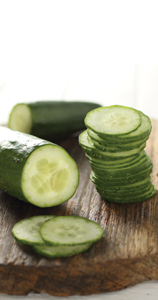1/15/2009
Japanese Cucumber
Masaki Kashiwagi

Japanese cucumbers are smaller and have few to no seeds, making them a wonderful fresh produce item. They have a smooth dark-green skin with light-green internal flesh. The skin is very tender so there’s no need for peeling before eating. They have a distinctive crisp texture that is second to none. Japanese cucumbers have less bitter flavors compared to other common cucumbers. And best of all, with a little effort, they make an excellent item for the home garden.
When it comes to cucumbers, freshness is key. Cucumbers are high in moisture content, making them perishable but also desirable when presented at the peak of freshness. They are a good source of vitamins C and A, potassium, manganese, folate, dietary fiber and magnesium. They are cool, crisp, nutritious and, as dieters know, low in calories.
Summer Dance is a hybrid Japanese cucumber bred by Takii and Co., Ltd. It produces glossy, deep-green fruit about 8 in. long, and approximately 1 in. in diameter. Summer Dance is high yielding and vigorous with a high resistance to downy and powdery mildews. It also has an intermediate resistance to Corynespora blight and target spot.
Production Tips
Temperature. The optimum temperature for germination is around 77F (25C). Under either low temperatures (less than 50F or 10C) or high temperatures (more than 104F or 40C), germination is reduced. The optimum temperature for growing is between 64F and 77F (18C and 25C). Growth
is slower above 77F (25C), whereas growth is stopped in temperatures below 50F to 53F
(10C to 12C).
Soil. Cucumber plants have a low tolerance for dry conditions due to their shallow roots.
Suitable soil has the ability to retain water and an air permeability like sandy loam soil. If
irrigated sufficiently, they can be grown even in sandy soil. The optimum soil acidity ranges
from pH 6 to pH 7.
Fertilization. Soil conditioning with manure and lime 15 days before planting is important for vigorous growth. Cucumber roots need oxygen and don’t like dry conditions, so it’s important to apply sufficient nutrition. Additional fertilizer should be given when female flowers bloom. Check fruit as it begins to develop. A lack of fertilizer or water can cause deformed fruit.
Preparing beds and planting. Make a bed 3 ft. wide and 8 in. high. Spacing between plants is 16 to 20 in. Plant three to four seeds at the depth of 1 in. After covering with soil, apply a light mulch of straw or peat moss. When plants have three to four true leaves, keep the healthiest and most vigorous plants and thin out others. When thinning, cut seedlings at the soil surface rather than pull them out, as the movement may cause damage to the root systems of the plants you want to keep.
Trimming and staking. Keep the primary vine. Pinch out all secondary vines up to the fifth node. Female flowers form on the first node of the secondary vines. Keep at least two leaves beyond the flower node and pinch the secondary vine. This ensures the plant will have enough energy to develop the fruit on that secondary vine. Pinching after at least two leaves allows the plant to develop strong fruit further up the primary vine. Each plant will require a trellis or stake to support the primary vine.
Harvest. Cucumbers will be ready to harvest seven to 10 days after flowering. It’s important to harvest fruit at the proper time to maintain plant vigor.
Storage. Store fruit by wrapping in newspaper or placing in a plastic bag without sealing. The optimum temperature for storage is below 50F (10C).
Japanese cucumbers are a unique item for home gardeners. So why not try them? After all, 125 million people in Japan can’t be wrong.
Masaki Kashiwagi is vegetable product development manager for Takii & Co. LTD.